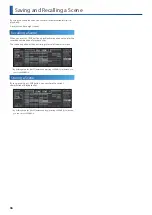
42
Editing the TONE Track
STRUCT
Structure lets you play two partials as a pair.
By using partial 1 or 3 (the carrier) to modulate the other partial 2 or
4 (the modulator), you can create a wide range of tonal characters.
Parameter
Value
Explanation
OSC1-2/OSC3-4
Partial 2 is used to modulate the sound of partial 1.
OFF
off
SYNC
This implements the oscillator sync function
that is provided by analog synthesizers.
The oscillator of partial 1 is reset at pitch
cycles of partial 2.
* This is available only when OSC Type is Virtual
Analog or PCM Sync.
RING
This implements the ring modulator that is
provided by analog synthesizers.
The output of partial 2 is multiplied with
partial 1.
&
XMOD
XMOD2
This implements the cross modulation
function that is provided by analog
synthesizers.
The output of partial 2 is applied as the
pitch of partial 1.
&
OSC1 / OSC3
0–127
Adjusts the volume of OSC 1/3.
OSC2 / OSC4
0–127
Adjusts the volume of OSC 2/4.
RING
(RING1-2 Level)
0–127
Adjusts the volume of ring modulation.
MOD
(XMOD)
0–9600 [cent]
(XMOD)
0–127 (XMOD2)
Adjusts the depth of cross modulation.
PENV
Here you can make pitch envelope settings.
Parameter
Value
Explanation
DEPTH
(Depth)
-100–+100
Specifies the depth of the pitch envelope.
Higher values make the pitch envelope
produce greater change. Negative “-” values
invert the shape of the envelope.
If the OSC Type is other than VA, this is
limited to ±63.
ATTACK
(T1)
0–1023
Specifies the time over which the initial
value changes to the maximum value after
the note starts.
DECAY
(T3)
0–1023
Specifies the time over which the SUSTAIN
value is reached following the ATTACK.
SUSTAIN
(L3)
-511–+511
Specifies the sustain value of the pitch
envelope.
LFO
Here you can make LFO settings.
Parameter
Explanation
FROM
Specifies the LFO waveform.
SIN
Sine wave
TRI
Triangle wave
SAW-UP
Sawtooth wave
SAW-DW
Sawtooth wave (negative polarity)
SQR
Square wave
RND
Random wave
TRP
Trapezoidal wave
S&H
Sample and Hold wave (changes the LFO
value once every cycle)
CHS
Sine wave modified by a VSIN chaos wave.
The amplitude of a sine wave is randomly
changed once every cycle.
VSIN
Modified sine wave. The amplitude of the
sine wave is randomly varied once every
cycle.
STEP
A waveform generated from data specified
by LFO Step 1–16.
This produces a fixed pattern of stepped
change like a step modulator.
You can edit this in the TONE PARTIAL EDIT
screen.
&
Refer to “Detailed Sound Editing” (p.
RATE
0–1023, 1/64T–4
This is available if Rate Sync is OFF.
It specifies the LFO cycle regardless of the
tempo. Higher values shorten the LFO
cycle.
>CUTOFF
(Filter Depth)
-100–+100
Specifies the depth at which the LFO is
applied to the cutoff frequency.
>PITCH
(Pitch Depth)
-100–+100
Specifies the depth at which the LFO is
applied to pitch.
* If OSC Type is other than Virtual Analog, the
range is limited to -63–+63.
>AMP
-100–+100
Specifies the depth at which the LFO is
applied to volume.
>PAN
-63–+63
Specifies the depth at which the LFO is
applied to pan.
FENV
Here you can make filter envelope settings.
Parameter
Value
Explanation
ATTACK
(T1)
0–1023
Specifies the time over which the initial
value changes to the maximum value after
the key is pressed.
DECAY
(T3)
0–1023
Specifies the time over which the SUSTAIN
value is reached following the ATTACK.
SUSTAIN
(L3)
0–1023
Specifies the sustain value of the filter
envelope.
RELEASE
(T4)
0–1023
Specifies the time over which the minimum
value is reached after the key is released.
MATRIX
Here you can connect various parameters as if you were patching
them.
You can connect up to four parameters.
Parameter
Value
Explanation
FROM
For an explanation
of each parameter,
refer to the
parameter list.
Specifies the control-source signal.
* If you specify SycCtrl 1–4, you can use the
panel [FILTER] [MOD] [FX] knobs to control
the parameters.
TO
Specifies the parameter that is controlled.
&
For an explanation of each parameter,
refer to “Parameter List” (p. 61).
DEPTH
(Depth)
-63–+63
Specifies the amount (depth) by which the
parameter is varied.
















































